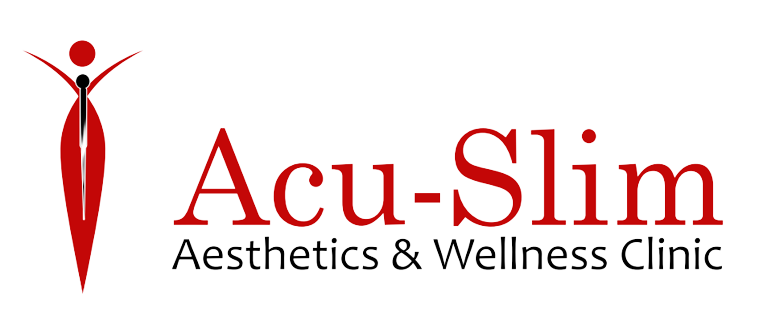Science Behind Obesity
BRAIN :
Three main areas of the brain contribute to the neurobiology of obesity. These are the hypothalamus, the mesolimbic area and executive function areas.
1.HYPOTHALAMUS :
OBESITY occurs when there is an imbalance between energy intake and energy expenditure, and the hypothalamus is at the centre of it.
2.THE MESOLIMBIC AREA:
This can override both physiological hunger and satiety to influence feeding behaviour.
In particular, palatable food increases dopamine levels in the mesolimbic system.
3.The prefrontal cortex:
This is involved in higher cognitive and executive control functions such as regulating emotions, impulses, desires and cravings including those in relation to food.
During a chronic stress, a network develops in the brain which favours mesolimbic responses. This results in a strong drive to eat which combined with an impaired capacity to inhibit eating can lead to obesity.
HORMONES INVOLVED IN OBESITY
Leptin is produced by adipose tissue and acts in the hypothalamus to prevent weight gain by reducing food intake and decreasing the motivational drive for palatable foods.
However, although there are higher levels of circulating leptin in people living with obesity, this does not suppress food intake.
Insulin levels correlate with energy balance and levels fall with starvation and rise with obesity.Insulin is a key hormone involved in glucose homeostasis through actions on skeletal muscle, liver and adipose tissue.
When higher circulating insulin levels are necessary to achieve glucose homeostasis, a subject is considered insulin resistant.Extensive studies on the molecular etiology of type 2 diabetes have revealed that low-grade chronic inflammation in those living with obesity mediates insulin resistance which can obesity. Sub-clinical hypothyroidism with elevated TSH and normal peripheral thyroid hormone concentration has been consistently found in obese subjects.Similarly, thyroid hormones are consistently dysregulated in lead to type 2 diabetes.
Menopausal women are three times more likely to develop obesity compared to premenopausal women.
Decreased levels of oestrogen play an important role in the development of obesity in menopausal women.16 The absence of oestrogen causes a variation in the lipid profile of post-menopausal and also causes predominant abdominal fat accumulation.
Growth hormone stimulates growth in children and in adults. Its main role is to regulate metabolism. Growth hormone secretion, both spontaneous and that evoked by stimuli, is blunted in obesity.
Similarly, thyroid hormones are consistently dysregulated in obesity. Sub-clinical hypothyroidism with elevated TSH and normal peripheral thyroid hormone concentration has been consistently found in obese subjects.
To understand what the effective strategies for obesity management are, we need to consider, physiological, psychological and biological factors of obesity. Although diet modification and exercise continue to be key in the management of obesity, increasingly patients require pharmacological adjuncts in order achieve or maintain weight loss.
Losing weight and sustaining it is hard .
Body weight is influenced by many different factors, including
- Genetic
- Environmental
- Physiological
After losing weight, your body will try to gain it back by making you feel more hungry and less full. After weight loss, your body tends to burn fewer calories or slow its metabolism.
Overall, the changes in your hormones directly influence your eating habits and your metabolism.
Obesity is a chronic disease and you don’t have to figure it all out alone. You can partner with your health care professional in managing your weight. There are several treatment options available for you.
The start is must, the one who begins to go through the hurdle will definitely able to achieve it at the end.
Weight management programme
If you are overweight, aim to lose between 5 and 10 % of your body weight trough healthy eating.
Daily Calorie intake is measured along with visceral and body fat percentage, accordingly they are reduced weekly to burn daily fat mass, without musle loss.
Daily we need 25 to 30 gms of fibre /day; Around 21 to 25 gms for women and 30 to 38 gms /day for men. 50% gms of proteins /day .
Dietary fiber is important to keep our digestive system healthy and to regulate our bowel movements daily. Fibres also keep us full for longer; also improves our blood sugars and cholesterol; to prevent us from heart diseases, diabetes and bowel cancer.
EXTRA TIPS TO FOLLOW:
Have Fruits and vegetables like cucumber with the skin
Cut on saturated fat ( butter/ ghee) and also excess of omega 6 PUFA ( sunflower and safflower oil)
Use olive oil/ Ground nut oil 2_3 tsp /day 9 MUFA based)
Take atleast 2- 3 Litre of water daily ( Take ½ L between meals)
EXERCISE Daily ( climb up the stairs, walk to nearby destinations, make a conscious effort to do stretching, aerobic and weight training exercise)
Do not do anything except eat when you sit down for a meal. Do not read, watch TV, talk on the phone, work etc. Make yourself aware of the food you are eating.
Prolong your meals by : eating slowly putting down your eating utensil between each bite.
When you are tempted to eat, try to use one of the following substitute activities: Take a walk, take a long bath, call a friend or get engaged in hobbies.
UNDERSTANDING THE FACTORS OF OVERWEIGHT / OBESITY
Its chronic and progressive disease now. it comes with lot of health challenges but it is one of the most prevalant.
How to evaluate the concern to know overweight / obesity?
Assesses muscle and body fat levels and rates the result as one of nine body types.
As your activity level changes the balance of body fat and muscle mass will gradually alter, which in turn will affect your overall physique.
Its important to calculate the risk by considering
AGE, MALE / FEMALE, HEIGHT / WEIGHT , BMI , HYPERTENSION / DIABETES / SMOKING / LIPID PROFILE / PHYSICAL ACTIVITY/ SEDENTARY LIFESTYLE.
Body composition analysis
In ACUSLIM WELLNESS clinic, we treat healthy mind with healthy body; as prevention is better than cure.
By checking patient’s body composition type, we also check fat% with body and visceral fat, BMI, WEIGHT analysis, bone mass, muscle mass, water content, daily calorie intake.
Patients are counselled about lifestyle modification, diet protocols are given and also if required, blood investigations are done to treat the cause of Obesity.
Thin built, lean body built with long limbs and small muscles bellies.
These group needs to eat good amount of proteins and complex carbohydrates regularly, though small frames should do exercises regularly, don’t overdo aerobics.
Wide shoulders with narrow waist, has natural tendency to be fit and relatively muscular, generally get in shape easily with regular workout and diet protocols. Should start with lower weights for muscle training and body shaping.
They tend to gain weight, wider built with wide hips and shorter limbs. They need to follow low calorie diet protocol daily with intermittent fasting of 12 hours daily for an inch loss with calorie burning exercises. 80 % is the diet what you eat everyday with daily strenuous workout to keep a balance of energy input and energy output.
Nine body types are categorised according to the fat & muscle distribution in the body. Where we can categorise every individual in detail to give them customised diet & exercise protocols.
According to the activity we do, that changes our body composition, & distribution of our fat content. So we need to find out fat %, muscle mass, bone weight, water content to know which type of body physique we have, accordingly when we are on weight loss programme, one should see the impact of a change in diet on the body to make sure the dieting is done in a healthy way. Also along with dieting, the fitness of daily workout by monitoring muscle mass & BMR is required. Monitoring of visceral fat is also equally important for the fitness.
VISCERAL FAT is a type of body fat that’s stored within the abdominal cavity, surrounding the vital organs in the abdomen. As we get older the distribution of fat changes & more likely can shift to the trunk area especially post menopause. So it’s required to know the healthy levels of visceral fat to prevent the risk of certain diseases like heart disease, high blood pressure, & the onset of type 2 diabetes.

Muscle mass includes the skeletal muscles, smooth muscles such as cardiac & digestive muscles & the water contained in these muscles. Muscles act as an engine in consuming energy.
Muscles play an important role as they act as an engine in consuming energy. As our muscle mass increases, that will increase energy consumption which can reduce excess body fat levels & lose weight in healthy way.

TOTAL BODY WATER
We should drink at least 8-ounce glasses of fluid a day, preferably water or other low calorie drinks. If you are training, it’s important to increase your water intake to ensure peak performance at all times.
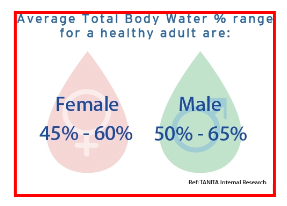
BONE MASS
The predicted weight of bone mineral in your body.
While your bone mass is unlikely to undergo noticeable changes in the short term, it’s important to maintain healthy bone density by having a balanced diet rich in calcium & by doing plenty of weight-bearing exercise.
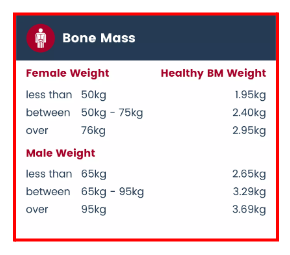
BASAL METABOLIC RATE
The daily minimum level of energy or calories your body requires when at rest (including sleeping) in order to function effectively.
Increasing muscle mass will speed up your basal metabolic rate (BMR). A person with a high BMR burns more calories at rest than a person with a low BMR.
About 70% of calories consumed every day are used for your basal metabolism. Increasing your muscle mass helps raise your BMR, which increases the number of calories you burn and helps to decrease body fat levels
DAILY CALORIE INTAKE
An estimate of how many calories you can consume within the next 24 hours to maintain your current weight. For weight loss protocol, daily reduction of calories is must for fat loss
BODY MASS INDEX
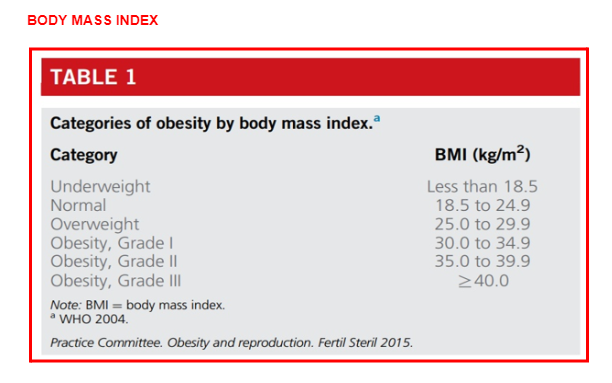
It’s a standardised ratio of weight to height.
Your BMI can be calculated by dividing your weight (in kilograms) by the square of your height (in meters).
BMI is a good general indicator for population studies but has serious limitation when assessing on an individual level.
IN ACUSLIM clinic, we access the body type of the patient, and from detailed clinical history and investigations, medical diagnosis is done.
We also assess a complete body measurements data where we measure body fat, visceral fat, body water content, bone & muscle mass, BMI & then a proper balanced diet with physical exercises are explained with lifestyle modification.
LIFESTYLE MODIFICATION
The aim of ACUSLIM wellness clinic is to achieve Fit and healthy happy mind with healthy body.
One complete session to understand every patient’s lifestyle is done to evaluate the root cause of Infertility.
Exercising regularly, eating well and managing stress have been proven to benefit the heart and vascular system. Taken together we call it lifestyle management, which is particularly vital to your health if you’re at risk for cardiovascular disease.
A number of lifestyle factors can impact on your overall health and wellbeing but just a few small changes can have big benefits.
Drinking Alcohol
Alcohol is high in calories and low in nutrition. It can also increase your blood pressure and cause liver damage. Women should try not to exceed 2 or 3 units per day.
Enough sleep
Night 8 hours sleep is must.
In Acuslim clinic, following protocol is been followed:
1. Clinical diagnosis
- KNOWING THE BMI
- Normal weight: <23 kg/m2*
- Overweight: 23 kg/m2–27.9 kg/m2
- Obesity: ≥28 kg/m2
- Evaluate checklist of obesity-related complications.
2. EVALUATION
Medical history
- Physical examination
- Clinical laboratory
- Review of systems, emphasizing obesity-related complications
- Obesity history
- Chart weight vs age
- Lifestyle patterns and preferences
- Previous interventions
3. Anthropometric diagnosis
To know the body type , we check body fat, visceral fat, bone weight, BMI,body water content, body muscle mass,Daily calorie intake as per above discussion.
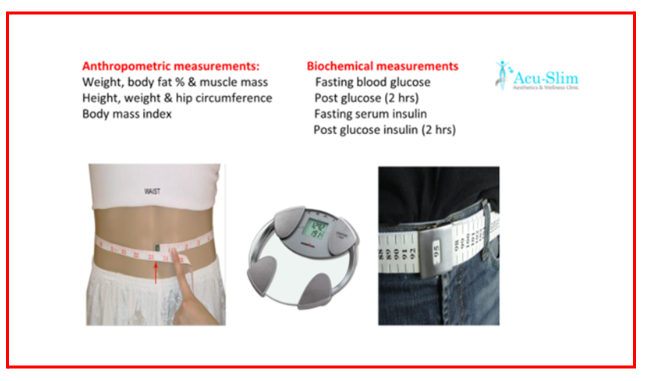
Measure waist circumference to evaluate cardiometabolic disease risk.
Obesity is associated with at least 60 comorbidities, some of which can be improved through weight loss.
It’s time to bring obesity to the forefront :
Weight loss can help improve some of your patients’ weight-related comorbidities.
DIAGNOSIS of OBESITY is very important for evaluation and right direction for the loss and maintenance to prevent comorbid conditions like osteo-arthritis, PCOD, Pre diabetes, Hypertension, Infertility, Dyslipidemia.
Metabolic and hormonal responses affect patient’s ability to maintain weight loss.
To treat Weight loss only by calorie restriction will cause imbalance by increasing hunger hormone (ghrelin) and decreasing satiety hormones.
Medical weight management has the potential to prevent these obesity-related complications but maintaining weight loss is typically challenging.
However, there are evidence-based approaches which increase the likelihood of long-term sustained weight loss.
